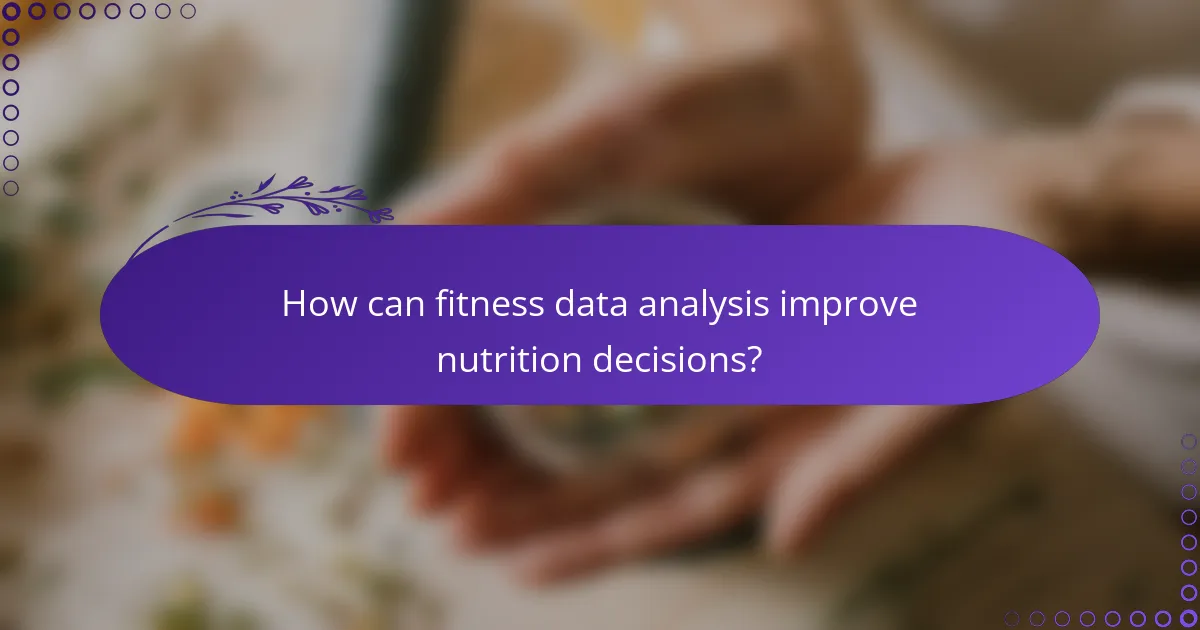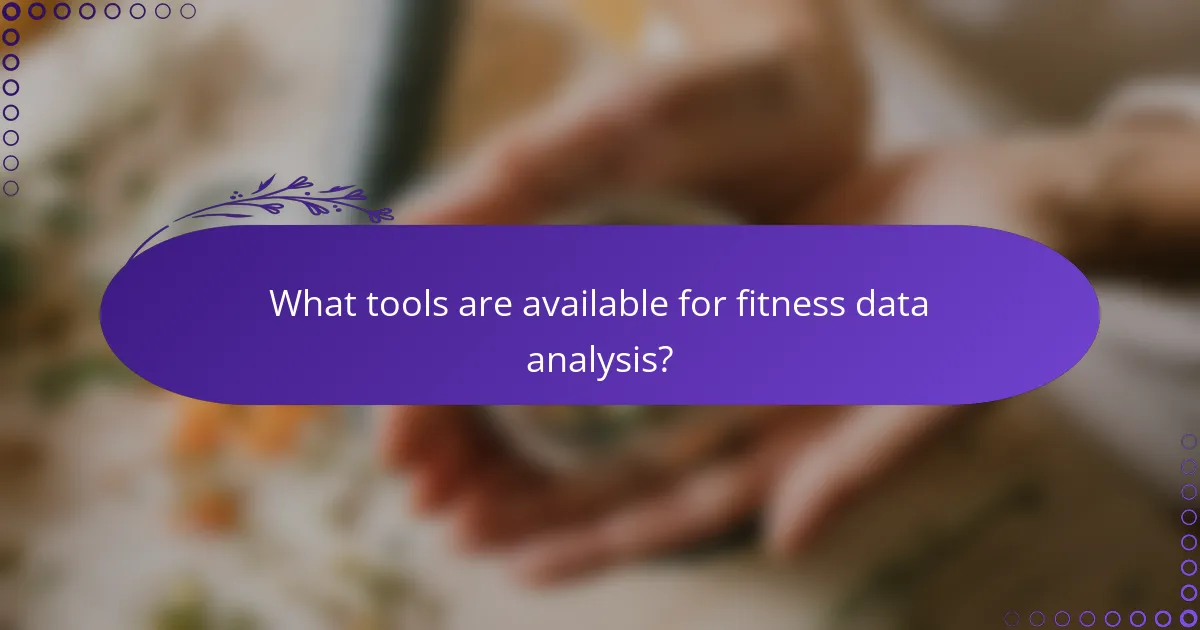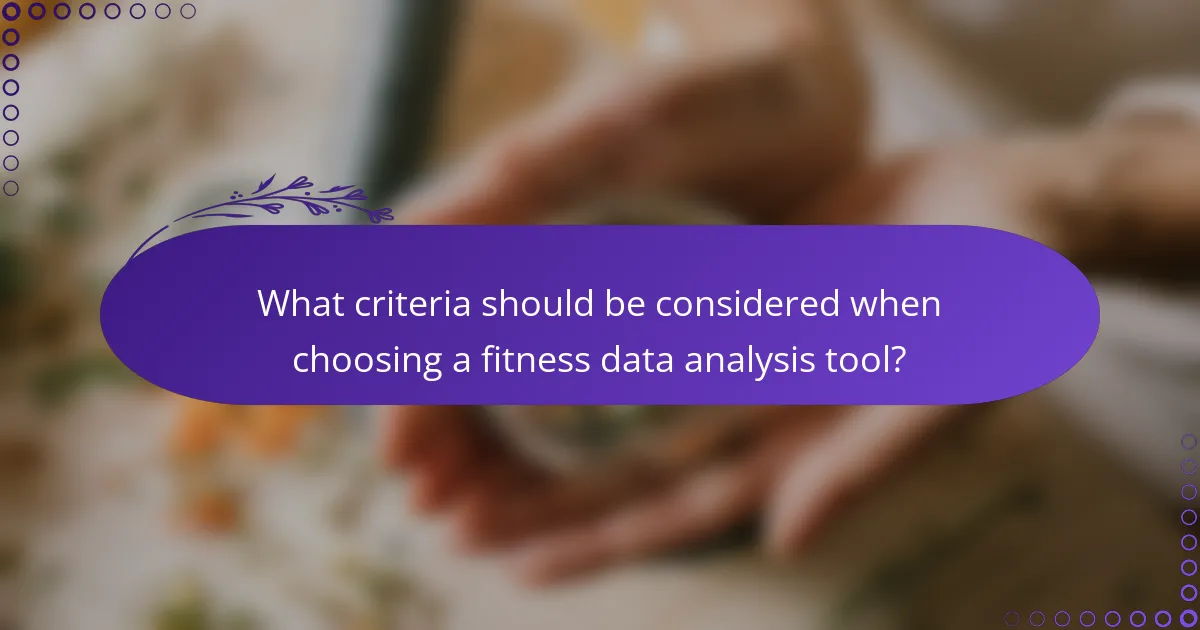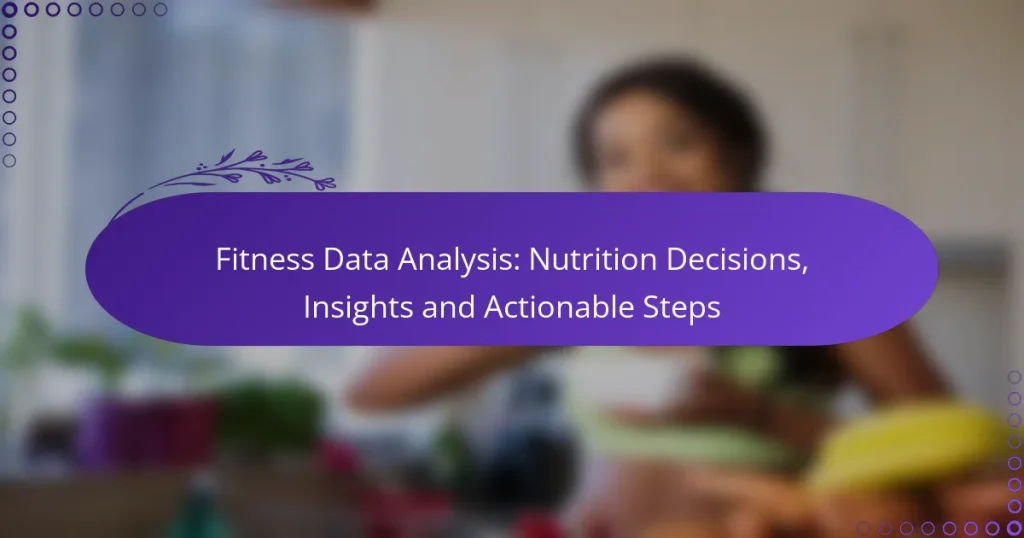Fitness data analysis plays a crucial role in optimizing nutrition decisions by offering valuable insights into dietary habits and nutrient intake. By utilizing tools like MyFitnessPal and Fitbit, individuals can track their nutrition and activity levels, enabling them to make informed choices that support their fitness goals and overall well-being.

How can fitness data analysis improve nutrition decisions?
Fitness data analysis enhances nutrition decisions by providing insights into dietary habits and nutrient intake. By leveraging this data, individuals can make informed choices that align with their fitness goals and overall health.
Identifying nutrient deficiencies
Fitness data analysis can help pinpoint nutrient deficiencies by tracking dietary intake against recommended daily values. For instance, if a person’s data shows consistently low iron intake, they may need to incorporate more iron-rich foods like spinach or lean meats into their diet.
Regularly reviewing nutrient intake can reveal patterns that may lead to deficiencies, allowing for timely adjustments. Utilizing tools like food diaries or nutrition apps can facilitate this process.
Tracking macronutrient intake
Monitoring macronutrient intake—carbohydrates, proteins, and fats—enables individuals to optimize their diets for specific fitness goals. For example, athletes may require higher protein levels to support muscle recovery, while those aiming for weight loss might focus on reducing carbohydrates.
Setting macronutrient targets based on personal goals and tracking progress can lead to better adherence and results. Many nutrition apps provide features to log and analyze macronutrient consumption easily.
Personalizing meal plans
Fitness data analysis allows for the personalization of meal plans tailored to individual needs and preferences. By considering factors such as activity level, body composition, and dietary restrictions, customized meal plans can be created to support specific fitness objectives.
For effective personalization, individuals can use data from their fitness routines and dietary habits to adjust meal components. This might include varying portion sizes or incorporating specific food groups that align with their goals.
Enhancing performance metrics
Analyzing fitness data can lead to improved performance metrics by correlating nutrition with physical output. For example, tracking how different meals affect energy levels during workouts can help identify optimal pre- and post-exercise nutrition.
Regularly assessing performance alongside dietary changes can reveal what works best for an individual, allowing for continuous improvement. This iterative process can significantly enhance overall fitness results.
Utilizing wearable technology
Wearable technology plays a crucial role in fitness data analysis by providing real-time insights into physical activity and nutrition. Devices like smartwatches can track calorie expenditure and heart rate, helping users understand their nutritional needs better.
Integrating data from wearables with nutrition apps can create a comprehensive view of health, allowing for informed adjustments to diet and exercise. This synergy can lead to more effective and sustainable nutrition decisions.

What tools are available for fitness data analysis?
Fitness data analysis tools help individuals track their nutrition and activity levels, providing insights to make informed health decisions. Popular options include MyFitnessPal, Fitbit, and Cronometer, each offering unique features tailored to different aspects of fitness monitoring.
MyFitnessPal for tracking
MyFitnessPal is a widely used app for tracking food intake and exercise. Users can log meals by searching a vast database or scanning barcodes, making it easy to monitor daily caloric intake and macronutrient distribution.
To maximize its effectiveness, set specific goals based on your fitness objectives, such as weight loss or muscle gain. Regularly updating your food diary can help identify patterns and areas for improvement, ensuring you stay on track.
Fitbit for activity monitoring
Fitbit devices track physical activity, heart rate, and sleep patterns, providing a comprehensive view of your daily health metrics. The app syncs with the device to display real-time data, allowing users to set activity goals and monitor progress over time.
Consider using the reminders to move feature, which prompts you to stay active throughout the day. This can help combat sedentary behavior, especially for those with desk jobs. Regularly reviewing your activity trends can inform adjustments to your fitness routine.
Cronometer for detailed nutrition
Cronometer offers a detailed approach to nutrition tracking, focusing on micronutrients as well as macronutrients. This tool is particularly beneficial for those with specific dietary needs or health conditions, as it provides comprehensive nutrient breakdowns.
When using Cronometer, pay attention to your intake of vitamins and minerals, especially if you’re following a restrictive diet. The app allows you to set personalized targets, helping you ensure you’re meeting your nutritional requirements effectively.

What actionable steps can be taken from data insights?
Data insights can lead to practical changes in nutrition and fitness routines. By analyzing your dietary habits and fitness data, you can make informed decisions that enhance your health and performance.
Adjusting caloric intake
Adjusting caloric intake is essential for achieving specific fitness goals, whether it’s weight loss, maintenance, or muscle gain. Start by determining your daily caloric needs based on factors like age, gender, activity level, and fitness objectives.
A common approach is to create a caloric deficit of about 500 calories per day for weight loss or a surplus of 250-500 calories for muscle gain. Use apps or food diaries to track your intake and ensure you stay within your target range.
Incorporating more whole foods
Incorporating more whole foods into your diet can improve overall nutrition and support fitness goals. Whole foods, such as fruits, vegetables, whole grains, lean proteins, and healthy fats, provide essential nutrients without added sugars and preservatives.
A practical step is to aim for at least five servings of fruits and vegetables daily. Consider meal prepping to include a variety of whole foods in your meals, making it easier to avoid processed options.
Setting realistic fitness goals
Setting realistic fitness goals helps maintain motivation and ensures progress. Start by defining specific, measurable, achievable, relevant, and time-bound (SMART) goals that align with your fitness data insights.
For instance, instead of aiming to lose 10 kg in a month, set a goal to lose 0.5-1 kg per week. Regularly review and adjust your goals based on your progress, and celebrate small milestones to stay motivated.

What criteria should be considered when choosing a fitness data analysis tool?
When selecting a fitness data analysis tool, consider factors such as user interface, integration capabilities, and data accuracy. These criteria will help ensure the tool meets your needs for effective nutrition decisions and actionable insights.
User interface and experience
The user interface (UI) of a fitness data analysis tool should be intuitive and easy to navigate. A clean design allows users to access features quickly, which is essential for maintaining engagement and consistency in tracking fitness data.
Look for tools that offer customizable dashboards, enabling you to prioritize the metrics that matter most to you. A good UI will also provide visual representations of data, such as graphs and charts, making it easier to interpret trends over time.
Integration with other apps
Integration with other applications is crucial for a seamless experience. A fitness data analysis tool that connects with popular health and fitness apps can streamline data collection and provide a more comprehensive view of your nutrition and exercise habits.
Check if the tool supports integrations with apps like MyFitnessPal, Strava, or wearable devices. This connectivity allows for automatic data syncing, reducing the need for manual input and minimizing errors.
Data accuracy and reliability
Data accuracy and reliability are paramount when choosing a fitness data analysis tool. Ensure the tool uses validated algorithms and sources to provide precise insights into your nutrition and fitness metrics.
Look for user reviews and expert recommendations that highlight the tool’s performance in real-world scenarios. A reliable tool should consistently deliver accurate data, helping you make informed decisions about your health and fitness journey.

How does fitness data analysis impact weight management?
Fitness data analysis significantly influences weight management by providing insights into personal trends and behaviors. By tracking metrics such as calorie intake, exercise, and body composition, individuals can make informed decisions to achieve their weight goals.
Monitoring weight trends
Monitoring weight trends involves regularly tracking your weight over time to identify patterns. This can help you understand whether your current habits are effective or if adjustments are necessary. Aim to weigh yourself weekly, noting fluctuations and averages to get a clearer picture of your progress.
Using apps or fitness trackers can simplify this process, allowing you to visualize trends and correlate them with dietary or activity changes. Remember, short-term fluctuations are normal; focus on long-term trends for meaningful insights.
Understanding body composition
Understanding body composition is crucial for effective weight management. Rather than just focusing on weight, consider the ratio of fat to muscle in your body. Tools like body fat scales or skinfold calipers can provide valuable information about your composition.
A healthy body composition typically involves a higher muscle mass and lower body fat percentage. Aim for a balanced approach that includes strength training and cardiovascular exercise to improve your overall body composition while managing weight.
Adjusting dietary habits
Adjusting dietary habits based on fitness data can lead to better weight management. Start by analyzing your calorie intake and macronutrient distribution. Tools like food diaries or nutrition apps can help you track what you eat and identify areas for improvement.
Consider adopting a balanced diet rich in whole foods, such as fruits, vegetables, lean proteins, and whole grains. Avoid drastic calorie cuts; instead, aim for gradual changes, such as reducing processed foods or increasing portion control, to foster sustainable weight loss.


